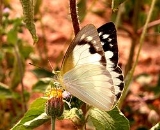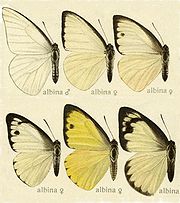
Appias albina
Encyclopedia
The Common Albatross is a small butterfly
of the family
Pieridae
(Yellows and Whites), that is found in India
and Australia
.
This butterfly closely resembles Appias paulina
but the males can distinguished by the more acutely pointed forewing and the females by the narrower oblique black band on the underside of the forewing. Other differences are given below.

Female is dimorphic
; differs as follows:
1st Form : Upperside - the posterior tornal portion of the black area on fore wing not inwardly rounded, but straight and generally diffuse. Underside : very like the underside of the dry-season form of A. paulina female, from which, however, it
differs by the narrowness of the oblique curved black band, the outer margin of which is irregularly zigzag, never evenly curved as in paulina.
2nd Form. Markings as in the 1st form but the ground-colour on the upperside entirely pale yellow. Underside : apical half of cell and disc of fore wing up to the black band pale sulphur-yellow ; the oblique curved black band as in the 1st form ; interspace 1 whitish ; the rest of the fore wing and the entire surface of the hind wing rich chrome-yellow.
Antennae, head, thorax and abdomen much as in A. paulina, but the antennae a dusky black and more closely speckled with white ; the thorax beneath in male white, never yellow.
In the females both dimorphs differ but little from the dimorphs of the wet-season form, only on the upperside the black on the apical half of the fore and on the terminal margin of the hind wing is more restricted, while on the underside the oblique curved black band that crosses the fore wing is distinctly narrower with a tendency to become diffuse.
The wing expanse is 60-74 mm.
Found in Sikkip up to 4000 feet, Bengal, Western and Southern India. Also extending into northeastern India, Burma and the Malay peninsula.
, Drypetes roxburghii and Drypetes venusta.

Butterfly
A butterfly is a mainly day-flying insect of the order Lepidoptera, which includes the butterflies and moths. Like other holometabolous insects, the butterfly's life cycle consists of four parts: egg, larva, pupa and adult. Most species are diurnal. Butterflies have large, often brightly coloured...
of the family
Family (biology)
In biological classification, family is* a taxonomic rank. Other well-known ranks are life, domain, kingdom, phylum, class, order, genus, and species, with family fitting between order and genus. As for the other well-known ranks, there is the option of an immediately lower rank, indicated by the...
Pieridae
Pieridae
The Pieridae are a large family of butterflies with about 76 genera containing approximately 1,100 species, mostly from tropical Africa and Asia. Most pierid butterflies are white, yellow or orange in coloration, often with black spots...
(Yellows and Whites), that is found in India
India
India , officially the Republic of India , is a country in South Asia. It is the seventh-largest country by geographical area, the second-most populous country with over 1.2 billion people, and the most populous democracy in the world...
and Australia
Australia
Australia , officially the Commonwealth of Australia, is a country in the Southern Hemisphere comprising the mainland of the Australian continent, the island of Tasmania, and numerous smaller islands in the Indian and Pacific Oceans. It is the world's sixth-largest country by total area...
.
Description
- See glossaryGlossary of Lepidopteran termsThis glossary describes the terms used in the formal descriptions of insect species, jargon used mostly by professionals or entomologist....
for terms used
This butterfly closely resembles Appias paulina
Appias paulina
The Common Albatross, Christmas Island White or Ceylon Lesser Albatross is a butterfly of the Pieridae family...
but the males can distinguished by the more acutely pointed forewing and the females by the narrower oblique black band on the underside of the forewing. Other differences are given below.

Wet-season form
Males have the upper forewings irrorated with black scales at the apex and along termen anteriorly much more sparse and narrow generally than in paulina. Underside has the: apex of fore and the whole surface of the hind wing pale dull ochraceous, sometimes with a faint pinkish tint, but never pale yellow as in paulina.Female is dimorphic
Sexual dimorphism
Sexual dimorphism is a phenotypic difference between males and females of the same species. Examples of such differences include differences in morphology, ornamentation, and behavior.-Examples:-Ornamentation / coloration:...
; differs as follows:
1st Form : Upperside - the posterior tornal portion of the black area on fore wing not inwardly rounded, but straight and generally diffuse. Underside : very like the underside of the dry-season form of A. paulina female, from which, however, it
differs by the narrowness of the oblique curved black band, the outer margin of which is irregularly zigzag, never evenly curved as in paulina.
2nd Form. Markings as in the 1st form but the ground-colour on the upperside entirely pale yellow. Underside : apical half of cell and disc of fore wing up to the black band pale sulphur-yellow ; the oblique curved black band as in the 1st form ; interspace 1 whitish ; the rest of the fore wing and the entire surface of the hind wing rich chrome-yellow.
Antennae, head, thorax and abdomen much as in A. paulina, but the antennae a dusky black and more closely speckled with white ; the thorax beneath in male white, never yellow.
Dry season form
Upper and under sides : similar to that of the wet-season specimens, but in the male the dusting of black scales on the upperside has almost, in some specimens completely, disappeared, while on the underside the ochraceous colouring is much paler.In the females both dimorphs differ but little from the dimorphs of the wet-season form, only on the upperside the black on the apical half of the fore and on the terminal margin of the hind wing is more restricted, while on the underside the oblique curved black band that crosses the fore wing is distinctly narrower with a tendency to become diffuse.
The wing expanse is 60-74 mm.
Found in Sikkip up to 4000 feet, Bengal, Western and Southern India. Also extending into northeastern India, Burma and the Malay peninsula.
Larva
"Light green with a yellow-white spiracular band from segments 2 & 3 to segment 12, where the band expands somewhat. Head round, shining, yellow .... covered with small conical setiferous black tubercles ; body rugose, with six transverse rows from above the spiracular region over the dorsum, of small, shining, setiferous, conical black tubercles to each segment ; segments 2, 12 and 13 have only a few transverse rows of such tubercles."Pupa
"Dirty whitish, with a pink shade on segments 4 to 14. The head-process from between the eyes is long, flattened at the sides, slightly curved, pointed at the extremity .... edges on ventral surface minutely serrated. The front margin of segment 2 is produced into a small subdorsal tooth, and the dorsal line is rather strongly carinated ; thorax highly carinated on the dorsal line . . . . ; lateral teeth of segments 6, 7 and 8 are all of the same size and are pointed . . . . ; the head-production, the points on segment 2, the teeth on segments 6 and 7 (sometimes) and the extremity of the cremaster black." (After de Niceville.)Food plants
Drypetes oblongifoliaDrypetes oblongifolia
Drypetes oblongifolia is a plant species of the genus Drypetes and the family Putranjivaceae.It is found in the shola forest of Kerala, a state in India.It is a host for larvae of the butterfly species Appias albina and Appias india....
, Drypetes roxburghii and Drypetes venusta.

See also
- PieridaePieridaeThe Pieridae are a large family of butterflies with about 76 genera containing approximately 1,100 species, mostly from tropical Africa and Asia. Most pierid butterflies are white, yellow or orange in coloration, often with black spots...
- List of butterflies of India
- List of butterflies of India (Pieridae)

